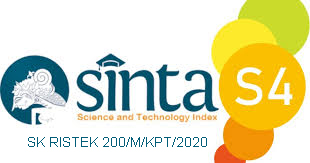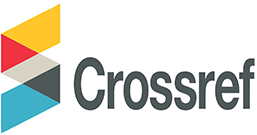The Implementation of Augmented Reality Hairstyles at Beauty Salons Using the Viola-Jones Method (Case Study: Eka Salon)
Abstract
Keywords
Full Text:
PDFReferences
Brianorman, Y., & Komputer, J. S. (2015). METODE EIGENFACE PADA SISTEM ABSENSI. Sistem Komputer Untan, Volume 03 No. 1 : 41-50
Damanik, R. R., Sitanggang, D., & Pasaribu, H. (2018). An application of viola jones method for face recognition for absence process efficiency An application of viola jones method for face recognition for absence process efficiency. Conference Series PAPER: 0–8.
Dan, D., Fitur, R., & Pada, M. (2015). CITRA WAJAH MENGGUNAKAN HAAR CASCADE. IDeaTech 2015: 298–305.
Hbali, Y., Ballihi, L., Sadgal, M., & Abdelaziz, E. F. (2016). Face Detection for Augmented Reality Application Using Boosting-based Techniques. International Journal of Interactive Multimedia and Artificial Intelligence, Vol. 4: 22-28.
Huang, J., Shang, Y., & Chen, H. (2019). Improved Viola-jones face detection algorithm based on HoloLens. Huang et al. EURASIP Journal on Image and Video Processing ,Vol.6.
Kirana, C. (2016). Face Identification For Presence Applications Using Violajones and Eigenface Algorithm. SISFOKOM, Vol.5: 7–14.
Kurdy, M. (2018). EMOTION RECOGNITION USING FACIAL EXPRESSION. Journal of Theoretical and Applied Information Technology, Vol.96. No 18 : 6118-6129.
Paul, T., Shammi, U. A., Kobashi, S., & Detection, M. F. (2018). A Study on Face Detection Using Viola-jones Algorithm in Various Backgrounds, Angles and Distances. Biomedical Soft Computing and Human Sciences, Vol.23, No.1, pp.27-36.
Prasetya, D. A., & Nurviyanto, I. (2012). Deteksi wajah metode viola jones pada opencv menggunakan pemrograman python. Simposium Nasional RAPI XI FT UMS: 18–23.
Priyadharsini, G. R., & Krishnaveni, K. (2016). An Analysis of Adaboost Algorithm for Face Detection. Indian Journal of Science and Technology, Vol 9(19) :1-4.
Putro, M. D. (2012). Sistem Deteksi Wajah dengan Menggunakan Metode Viola-Jones. Science, Engineering and Technology 2012 : 1-5.
Rian, R., Putra, C., Juniawan, F. P., Studi, P., Informatika, T., & Analysis, L. D. (2017). PENGENALAN WAJAH PADA SISTEM KEHADIRAN MAHASISWA BERBASIS ANDROID, Jurnal Telematika Vol. 10 No. 1 : 132- 146.
Singh, V., Shokeen, V., & Singh, B. (2013). FACE DETECTION BY HAAR CASCADE CLASSIFIER WITH SIMPLE AND COMPLEX BACKGROUNDS IMAGES USING OPENCV IMPLEMENTATION. International Journal of Advanced Technology in Engineering and Science, Volume No.01: 33-38.
Tripathi, R. C. (2011). R EAL T IME F ACE R ECOGNITION U SING A DA B OOST I MPROVED F AST PCA A LGORITHM. International Journal of Artificial Intelligence & Applications (IJAIA), Vol.2, No.3 : 46- 58.
Zul, M. I., Muslim, I., & S, A. K. (2017). Identifikasi Bentuk Frame Kacamata dengan Metode Pengukuran Pixel dan Algoritma k-NN. Jurnal Infotel Vol.9 No.4 : 429-435.
DOI: https://doi.org/10.31326/jisa.v3i2.847
Refbacks
- There are currently no refbacks.
Copyright (c) 2021 Graha Virgian Gustira P, Ade Syahputra

This work is licensed under a Creative Commons Attribution-ShareAlike 4.0 International License.
JOURNAL IDENTITY
Journal Name: JISA (Jurnal Informatika dan Sains)
e-ISSN: 2614-8404, p-ISSN: 2776-3234
Publisher: Program Studi Teknik Informatika Universitas Trilogi
Publication Schedule: June and December
Language: English
APC: The Journal Charges Fees for Publishing
Indexing: EBSCO , DOAJ, Google Scholar, Arsip Relawan Jurnal Indonesia, Directory of Research Journals Indexing, Index Copernicus International, PKP Index, Science and Technology Index (SINTA, S4) , Garuda Index
OAI address: http://trilogi.ac.id/journal/ks/index.php/JISA/oai
Contact: jisa@trilogi.ac.id
Sponsored by: DOI – Digital Object Identifier Crossref, Universitas Trilogi
In Collaboration With: Indonesian Artificial Intelligent Ecosystem(IAIE), Relawan Jurnal Indonesia, Jurnal Teknologi dan Sistem Komputer (JTSiskom)
JISA (Jurnal Informatika dan Sains) is Published by Program Studi Teknik Informatika, Universitas Trilogi under Creative Commons Attribution-ShareAlike 4.0 International License.


















